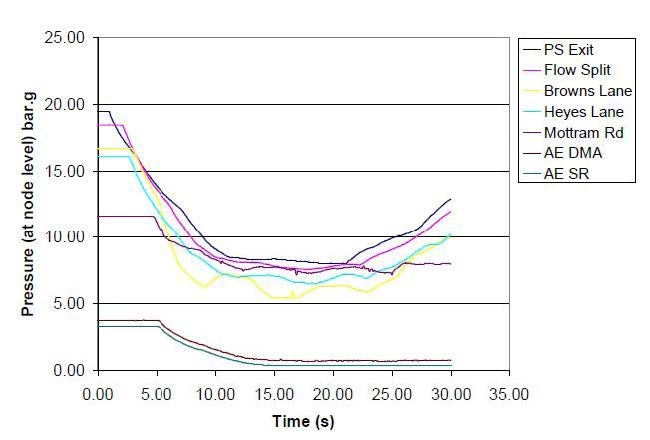Rising Main Surge Analysis
A needs study by our client identified that there was a significant risk of interruption to the District Metered Areas (DMA’s) supplied by the Wilmslow high lift Pumping Station (PS) and Alderley Edge Service Reservoir (SR). The existing high-lift pumps were also thought to be the cause of pipe bursts during emergency stop conditions. To mitigate the risk, the Wilmslow pumps were to be replaced due to their age and condition, the rising main was to be improved, and alternative inlet and outlet valve arrangements were to be installed on the Wilmslow Contact Tank (CT).
The Wilmslow network draws 22 Ml/day of water from the Hazel Grove SR, 10 Ml day of which is consumed by an industrial unit, while the remainder is transferred to the Wilmslow CT. The low and high lift pumps at Wilmslow deliver water to various DMA’s and the Alderley Edge SR.
Our Approach
This study involved the conversion of a SynerGEE water distribution model into a Flowmaster network (Figure 2) so that a surge analysis could be conducted. This enabled the influence of the new pumps, improved pipes and valve arrangement to be understood without surge suppression equipment being added to the system. In particular, the study focused on establishing the system pressures for emergency pump stop operations. The targets were to ensure that the delivery pressure did not exceed the pipeline rating (leading to pipe failures) or fall below atmospheric pressure (leading to ground water ingress).
Figure 2: Flowmaster Network Model
The suction main pressure was also assessed to determine if it exceed the static pressures. Analysis of the unsuppressed system identified the delivery line fell below atmospheric pressure and the suction line exceeded the static pressure. Various surge suppression methods were investigated, including suction and delivery surge vessels, and the addition of flywheels to the high-lift pumps.
Results
MMI assessed the adequacy of the proposed equipment and pipe modifications prior to any on site changes. In this case, surge analysis was used to determine the unsuppressed system behaviour and to optimise the required surge equipment to ensure safe operation. The recommended equipment was a 5 m³ vessel upstream and a 2 m³ vessel downstream with a pump flywheel with an inertia of 80 kg m².
For more information surrounding our Surge Analysis capabilities, please contact us on 0117 960 2212 (Bristol) or email us.
